Are Toxic Backlinks Harming Your Site?
The Complete “Disavow” Guide for Scared Business Owners: Protect Your Rankings and Recover from Google Penalties
Table of Contents
- Introduction: The Hidden Danger Lurking in Your Backlink Profile
- What Are Toxic Backlinks? Understanding the Digital Poison
- Why Toxic Backlinks Matter: The Impact on Your Business
- How to Identify Toxic Backlinks: The Detective Work
- Essential Tools for Backlink Analysis
- The Disavow Process: Step-by-Step Guide
- Preventing Future Toxic Backlinks: Building a Healthy Profile
- Real-World Case Studies: Businesses That Recovered
- Frequently Asked Questions
- Conclusion: Taking Control of Your Backlink Profile
Introduction: The Hidden Danger Lurking in Your Backlink Profile
Imagine you’ve built a beautiful house (your website) with great content, excellent user experience, and products or services that genuinely help people. You’ve invested time, money, and effort into making it perfect. But what if I told you that unseen forces could be undermining your foundation, causing cracks in your structure that threaten to bring everything down?
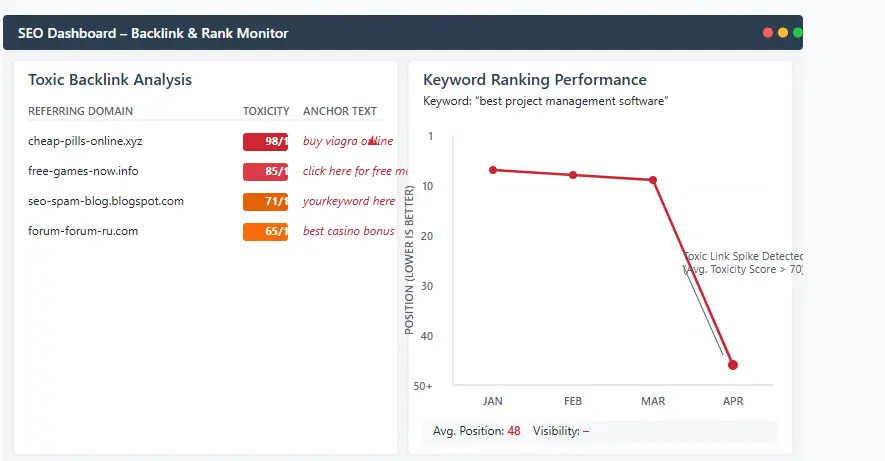
This is exactly what toxic backlinks do to your website. They’re like termites eating away at the wooden framework of your digital presence—silent, destructive, and potentially catastrophic if left untreated.
As a business owner, you might have heard the term “backlinks” in passing from your marketing team or SEO specialist. You might even know they’re important for search rankings. But what happens when these supposed assets turn into liabilities? What happens when the very things meant to boost your visibility start dragging you down into the depths of search engine obscurity?
This comprehensive guide is designed specifically for business owners who are concerned about toxic backlinks but feel overwhelmed by the technical jargon and complexity of the disavow process. We’ll walk you through everything you need to know in plain English, with actionable steps you can take immediately to protect your online business.
By the end of this guide, you’ll understand:
- What toxic backlinks are and why they’re dangerous
- How to identify these harmful links in your backlink profile
- The step-by-step process to disavow toxic links
- How to prevent future toxic backlinks from harming your site
- When to seek professional help versus handling it yourself
Let’s begin by understanding exactly what we’re dealing with.
What Are Toxic Backlinks? Understanding the Digital Poison
In the simplest terms, toxic backlinks are incoming links from other websites that harm rather than help your search engine rankings. Think of them as bad references in a job application—instead of vouching for your credibility, they raise red flags and question your authority.
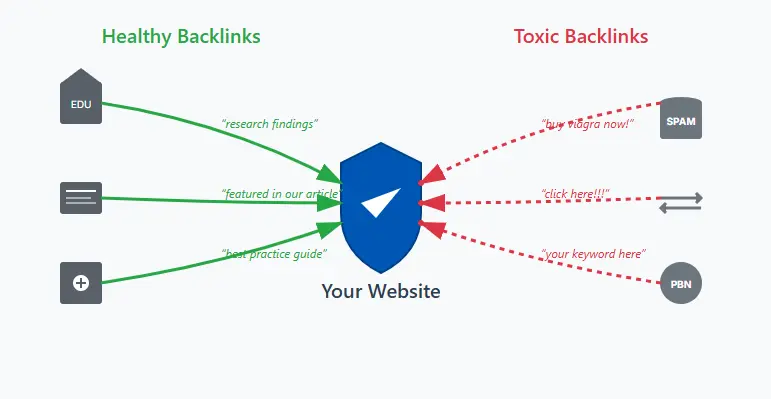
Google’s algorithm is designed to evaluate the quality and relevance of backlinks to determine a website’s authority and ranking position. While high-quality backlinks from reputable sources can significantly boost your rankings, toxic backlinks send negative signals that can result in penalties.
The Anatomy of a Toxic Backlink
Toxic backlinks typically exhibit one or more of the following characteristics:
- From low-quality or spammy websites: Sites with thin content, excessive ads, or poor user experience
- Irrelevant to your niche: Links from completely unrelated industries or topics
- Part of link schemes: Purchased links, excessive link exchanges, or links created specifically to manipulate PageRank
- From penalized sites: Websites that have already been penalized by Google
- With over-optimized anchor text: Unnatural use of exact-match keywords in link text
- From link networks: Groups of websites created solely for linking purposes
- From foreign language sites: When irrelevant to your business and audience
- From sites with high malware or spam scores: Sites flagged for security issues or spamming
Did You Know?
Google’s Penguin algorithm update (initially launched in 2012) was specifically designed to target websites with spammy backlink profiles. This algorithm now runs in real-time, meaning toxic backlinks can impact your rankings almost immediately. Learn more about Penguin’s evolution.
How Toxic Backlinks Are Created
Understanding how toxic backlinks are created can help you identify and prevent them. Common sources include:
- Previous SEO agencies: Some agencies use outdated or black-hat techniques that generate toxic links
- Negative SEO attacks: Competitors intentionally building bad links to your site
- Automated scraping: Bots that steal your content and create links back to your site
- Comment spam: Automated or manual spam comments on blogs with links to your site
- Forum profile spam: Links created in forum profiles or signatures
- Article directories: Low-quality article submission sites that accept any content
- Link farms: Networks of websites created solely for cross-linking
- Paid link schemes: Purchased links that violate Google’s guidelines
It’s important to note that not all of these sources are malicious. Some toxic backlinks might be created without your knowledge or intention, especially if you’ve worked with multiple SEO providers over the years.
Why Toxic Backlinks Matter: The Impact on Your Business
If you’re a busy business owner, you might be wondering if toxic backlinks are really worth your attention. After all, you have products to develop, customers to serve, and a business to run. Can a few bad links really make that much difference?
The short answer: Yes, they absolutely can.
The Direct Impact on Search Rankings
Google’s algorithm has become increasingly sophisticated at identifying manipulative link practices. When it detects toxic backlinks pointing to your site, it may respond in several ways:
- Manual action: A human reviewer at Google determines your site violates guidelines and applies a penalty
- Algorithmic penalty: The Penguin algorithm automatically reduces your rankings based on your backlink profile
- Devaluation: Specific pages or your entire site loses authority and ranking potential
The Ripple Effect on Your Business
The impact of toxic backlinks extends beyond just search rankings. Consider these potential consequences:
- Reduced organic traffic: Lower rankings mean fewer visitors finding your site through search
- Decreased lead generation: Less traffic typically translates to fewer leads and customers
- Lower brand visibility: Reduced presence in search results decreases brand awareness
- Wasted marketing budget: Other marketing efforts become less effective without organic traffic support
- Competitive disadvantage: While you’re dealing with penalties, competitors are capturing your market share
- Recovery costs: Fixing toxic backlink issues requires time and potentially professional help
“We noticed a 40% drop in organic traffic over two months and couldn’t figure out why. After investigating, we discovered thousands of toxic backlinks from a previous SEO campaign. It took us six months to recover, and we estimate we lost over $50,000 in revenue during that period.”
The Long-Term Consequences
Beyond immediate financial impact, toxic backlinks can have lasting effects on your business:
- Domain authority damage: Your domain’s overall authority may be permanently affected
- Trust issues with Google: Even after recovery, Google may view your site with suspicion
- Reputation damage: If your site is associated with spammy neighborhoods, it can affect brand perception
- Future SEO challenges: A history of penalties can make future SEO efforts more difficult
The good news is that with proper identification and disavowal of toxic backlinks, most businesses can recover their rankings and traffic. However, prevention is always better than cure, which is why understanding this issue is so critical for business owners.
How to Identify Toxic Backlinks: The Detective Work
Before you can fix toxic backlink problems, you need to identify them. This process requires a combination of tools, knowledge, and careful analysis. Let’s break down the detective work into manageable steps.
Warning Signs of Toxic Backlinks
Sometimes, you don’t need to dig deep to know there’s a problem. These warning signs suggest you may have toxic backlink issues:
- Sudden ranking drops: Unexplained decreases in keyword rankings
- Traffic decline: Significant drops in organic search traffic
- Manual penalty notification: Message in Google Search Console about unnatural links
- Unusual backlink growth: Sudden spikes in backlink numbers from low-quality sites
- Keyword ranking anomalies: Ranking for unrelated or inappropriate terms
The Manual Review Process
While automated tools are helpful, nothing replaces a careful manual review of your backlink profile. Here’s how to approach it:
Step 1: Export Your Complete Backlink Profile
Use multiple tools to get a comprehensive list of all backlinks pointing to your site. No single tool captures everything, so combining data from several sources gives you the most complete picture. Consider starting with a thorough technical SEO audit to establish a baseline of your site’s health.
Step 2: Sort by Domain Authority
Start by examining links from the lowest authority domains. These are most likely to be toxic. Focus on domains with authority scores below 20-30 (depending on the tool you’re using).
Step 3: Check Relevance
For each suspicious domain, ask: Is this website relevant to my industry or audience? Links from completely unrelated sites are often toxic, especially if they appear in large numbers.
Step 4: Evaluate Site Quality
Visit the linking website and assess its quality. Look for red flags like thin content, excessive ads, poor design, spelling errors, and lack of contact information.
Step 5: Analyze Anchor Text
Check the anchor text used in the link. Over-optimized anchor text with exact-match keywords, especially when coming from low-quality sites, is a strong indicator of toxic links.
Step 6: Check Link Placement
Look at where on the page your link appears. Links in footers, sidebars, or among hundreds of other links are often less valuable and potentially toxic.
Step 7: Identify Patterns
Look for patterns that suggest link schemes. Multiple links from the same IP address, similar site structures, or identical content across linking domains are red flags. Use our technical SEO checklist PDF to ensure you’re covering all aspects of your analysis.
Creating a Toxic Link Spreadsheet
As you identify potentially toxic backlinks, organize them in a spreadsheet with these columns:
- URL of the linking page
- Domain of the linking site
- Anchor text used
- Date the link was first seen
- Domain authority/spam score
- Reason for flagging as toxic
- Action taken (disavow, remove, or keep)
This spreadsheet will become your working document as you move through the disavow process.
Essential Tools for Backlink Analysis
While manual review is crucial, having the right tools can make the process of identifying toxic backlinks much more efficient. Here are the most valuable tools for this task:
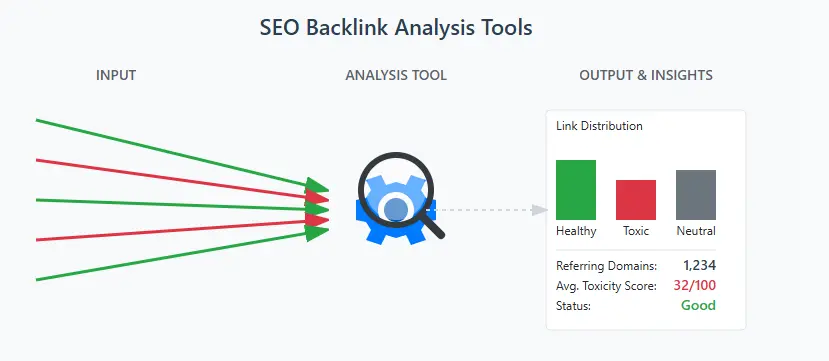
Google Search Console
Google Search Console is a free tool that provides insights directly from Google. It’s essential for any backlink analysis:
- Links report: Shows which sites link to you most frequently
- Top linking sites: Identifies domains sending the most links your way
- Top linking text: Reveals the most common anchor texts used
- Manual actions: Alerts you to any penalties Google has applied
Free Tool Tip
Google Search Console doesn’t show all your backlinks, but it does show the ones Google considers most important. Start here to identify the most impactful toxic links. Access Google Search Console.
Ahrefs
Ahrefs is one of the most comprehensive SEO tools for backlink analysis:
- Site Explorer: Provides detailed backlink profiles for any domain
- Domain Rating (DR): Ahrefs’ metric for domain authority
- Toxic Score: Identifies potentially harmful links
- Referring domains report: Shows all unique domains linking to you
- Anchor text analysis: Helps identify over-optimized anchor text
SEMrush
SEMrush offers robust backlink analysis capabilities:
- Backlink Audit Tool: Specifically designed to identify toxic backlinks
- Toxicity Score: Rates each backlink on a scale of 0-100
- Authoritative Score: SEMrush’s domain authority metric
- Outreach templates: Helps with link removal requests
Moz Link Explorer
Moz provides valuable insights into your backlink profile:
- Spam Score: Identifies potentially toxic links (0-17% is generally safe)
- Domain Authority (DA): Moz’s domain authority metric
- Linking domains: Shows all unique domains linking to your site
- Discovered and lost links: Tracks new and removed backlinks
Majestic
Majestic specializes in backlink analysis with unique metrics:
- Trust Flow: Measures the trustworthiness of linking sites
- Citation Flow: Measures the influence of linking sites
- Topical Trust Flow: Shows relevance of linking sites to specific topics
Choosing the Right Tool Combination
No single tool gives you the complete picture. The most effective approach combines:
- Google Search Console: For Google’s perspective on your links
- Ahrefs or SEMrush: For comprehensive analysis and toxicity scoring
- Moz or Majestic: For additional metrics and cross-validation
By using multiple tools, you can cross-reference findings and ensure you’re not missing any toxic backlinks that might be hiding from a single tool’s index.
The Disavow Process: Step-by-Step Guide
Once you’ve identified toxic backlinks, the next step is to disavow them. This process tells Google to ignore these links when evaluating your site. Here’s how to do it correctly:
Before You Disavow: Try Removal First
Google recommends attempting to remove toxic links before disavowing them. This shows you’ve made a good-faith effort to clean up your backlink profile.
Step 1: Document Everything
Keep detailed records of your removal efforts. This documentation is crucial if you ever need to file a reconsideration request with Google.
Step 2: Contact Webmasters
Reach out to the webmasters of the sites with toxic links. Be polite and specific about which links you want removed.
Step 3: Follow Up
If you don’t receive a response, follow up after 7-10 days. Keep records of all communication attempts.
Step 4: Document Unsuccessful Attempts
For links you can’t remove, document your unsuccessful attempts. This becomes part of your disavow file submission.
Creating Your Disavow File
When you’re ready to create your disavow file, follow these guidelines:
- Format: Create a plain text (.txt) file with UTF-8 encoding
- Structure: List one URL or domain per line
- Domain-level disavowal: Use “domain:example.com” to disavow all links from a domain
- Page-level disavowal: Use “http://example.com/page.html” to disavow a specific page
- Comments: Use “#” at the beginning of a line to add comments explaining your decisions
- File size: Keep the file under 2MB (100,000 lines maximum)
Sample Disavow File
Example Disavow File Structure
# Disavow file for example.com
# Created on June 15, 2023
# Contact: webmaster@example.com
# Pages with spammy content
http://spammysite1.com/links/page1.html
http://spammysite2.com/directory/example.html
# Entire domains with low quality
domain:badlinknetwork.com
domain:toxicdirectory.net
# Foreign language sites with no relevance
domain:foreign-russian-site.ru
domain:chinese-spam-directory.cn
Submitting Your Disavow File
Once your disavow file is ready:
Step 1: Verify Your Site in Google Search Console
You must have verified ownership of the site in Google Search Console to submit a disavow file.
Step 2: Access the Disavow Links Tool
Navigate to the Disavow Links tool within Google Search Console. Access the Disavow Tool.
Step 3: Select Your Property
Choose the exact property (domain or subdomain) you want to disavow links for.
Step 4: Upload Your File
Upload your .txt disavow file. Google will confirm receipt and processing.
After Submission: What to Expect
Once you’ve submitted your disavow file:
- Processing time: It may take several weeks for Google to process your disavow file
- No immediate confirmation: Google doesn’t notify you when disavowed links are ignored
- Gradual recovery: If you had a penalty, recovery may take 3-6 months or longer
- Monitor closely: Watch your rankings and traffic for changes
Preventing Future Toxic Backlinks: Building a Healthy Profile
Once you’ve cleaned up your existing toxic backlinks, the next step is prevention. Building a healthy backlink profile requires ongoing effort and vigilance. Here’s how to protect your site from future toxic backlinks:
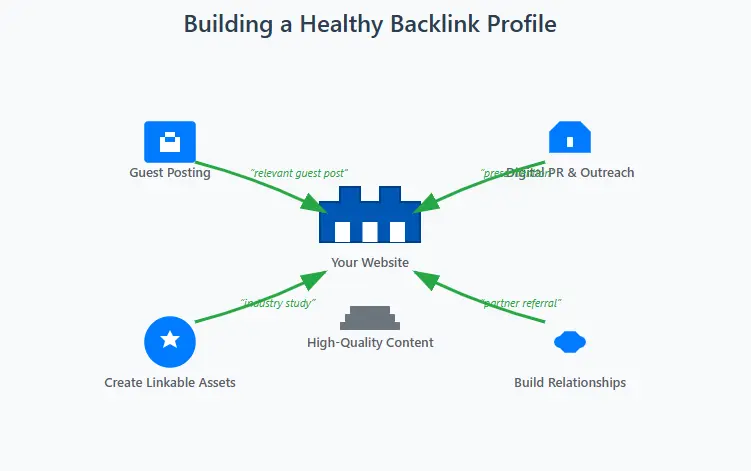
Vet Your SEO Providers Carefully
Many toxic backlink issues stem from previous SEO work. When hiring SEO providers:
- Ask for case studies: Request examples of their work and results
- Question their link building methods: Ensure they follow Google’s guidelines
- Request regular reports: Stay informed about new links being built
- Avoid guarantees: Be wary of promises of specific rankings or quick results
Monitor Your Backlink Profile Regularly
Set up a monitoring system to catch toxic backlinks early:
- Weekly alerts: Use tools to notify you of new backlinks
- Monthly reviews: Conduct a quick review of new links each month
- Quarterly deep dives: Perform a thorough analysis every quarter
- Annual audits: Complete a comprehensive backlink audit annually
Focus on Quality Over Quantity
When building new backlinks, prioritize quality:
- Relevant sites: Seek links from websites relevant to your industry
- High authority: Target sites with strong domain authority
- Real traffic: Verify that linking sites have actual visitors
- Editorial standards: Choose sites with genuine editorial review processes
Diversify Your Link Profile
A natural backlink profile includes diversity in:
- Anchor text: Mix branded, naked URL, generic, and keyword-rich anchors
- Link types: Include contextual, image, and resource links
- Page placement: Links should appear in various locations on pages
- Domain types: Include blogs, news sites, directories, and resource pages
Implement Best Practices for Link Building
Follow these white-hat link building strategies:
- Create exceptional content: Develop resources people naturally want to link to
- Guest blogging: Contribute valuable content to reputable sites in your niche
- Digital PR: Earn media coverage through newsworthy stories and data
- Broken link building: Find broken links on relevant sites and offer your content as replacement
- Resource page link building: Get listed on curated resource pages in your industry
- Unlinked brand mentions: Find mentions of your brand without links and request them
Beginner’s Resource
If you’re new to link building, check out our comprehensive guide on SEO link building for beginners to learn safe and effective strategies that won’t put your site at risk.
“After recovering from a toxic backlink penalty, we completely changed our approach to link building. Instead of chasing quantity, we focused on building relationships with industry publications and creating genuinely useful resources. Not only did our rankings recover, but they surpassed our previous highs, and our traffic quality improved significantly.”
Protect Against Negative SEO
Sometimes, toxic backlinks result from competitors trying to harm your rankings. To protect against negative SEO:
- Monitor new links: Set up alerts for new backlinks to catch suspicious activity early
- Disavow quickly: Act fast when you identify toxic links from negative SEO campaigns
- Document everything: Keep records of all suspicious activity for potential reporting
- Focus on quality: A strong, healthy backlink profile is more resistant to negative SEO
Real-World Case Studies: Businesses That Recovered
Theory is helpful, but real-world examples demonstrate the impact of toxic backlinks and the recovery process. Let’s examine three businesses that faced toxic backlink issues and successfully recovered.
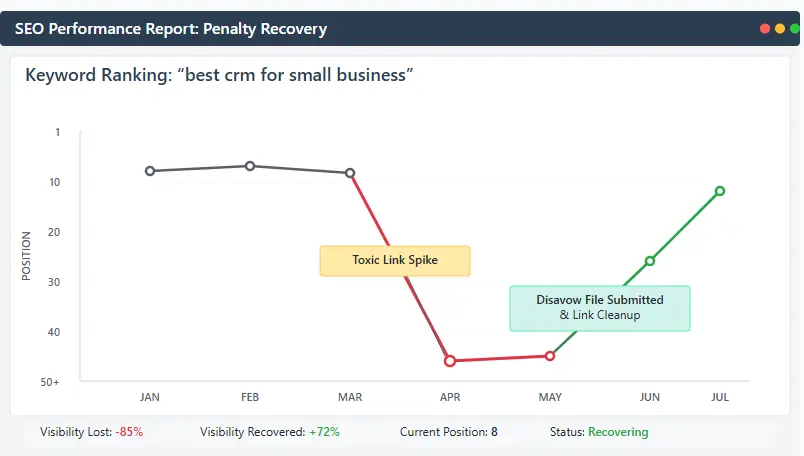
Case Study 1: E-commerce Store Hit by Negative SEO
Background: A mid-sized e-commerce store selling home goods noticed a sudden 60% drop in organic traffic over three weeks. Rankings for their top 20 keywords all fell off the first page.
Discovery: Upon investigation, they found over 5,000 new backlinks from low-quality domains, many with spammy anchor text like “best viagra online” and “casino bonus” – completely unrelated to their business.
Action Taken:
- Conducted a complete backlink audit using Ahrefs and SEMrush
- Documented all toxic links in a spreadsheet
- Attempted to contact webmasters (unsuccessful in most cases)
- Created and submitted a comprehensive disavow file
- Filed a reconsideration request with Google explaining the negative SEO attack
Results: After 4 months, the site recovered 80% of its previous rankings. By month 6, they had fully recovered and were even ranking for additional keywords.
Key Takeaway: Quick action and thorough documentation are crucial when dealing with negative SEO attacks.
Case Study 2: Local Business Penalized for Bad SEO Practices
Background: A local plumbing service hired a cheap SEO agency that promised “first-page rankings in 30 days.” After initial improvements, the site received a manual penalty from Google for “unnatural links.”
Discovery: The SEO agency had built hundreds of low-quality directory links, blog comments, and forum profile links with exact-match anchor text like “emergency plumber new york.”
Action Taken:
- Fired the SEO agency and conducted a full backlink audit
- Successfully removed 30% of toxic links through outreach
- Disavowed the remaining toxic links
- Submitted a detailed reconsideration request documenting their efforts
- Implemented a new content strategy focused on local expertise
Results: The manual penalty was lifted after 3 months. Within 6 months, the business was ranking in the local 3-pack for their primary service area and had increased organic leads by 45% compared to pre-penalty levels.
Key Takeaway: Quality SEO takes time, and shortcuts often lead to penalties that require significant recovery efforts.
Case Study 3: SaaS Company with Legacy Link Issues
Background: A B2B SaaS company had been operating for 10 years and worked with multiple SEO agencies over the years. They noticed gradual ranking declines over 18 months but couldn’t identify the cause.
Discovery: A comprehensive backlink audit revealed thousands of toxic links from various campaigns over the years, including article directories, link networks, and paid blog posts.
Action Taken:
- Conducted a historical analysis of all SEO work performed
- Identified and categorized toxic links by source and timeframe
- Removed 15% of toxic links through successful outreach
- Created a segmented disavow file, starting with the most toxic links
- Implemented a content-driven link building strategy focused on industry publications
Results: The company saw gradual improvement over 9 months, with a 35% increase in organic traffic by month 12. Their domain authority increased from 42 to 58, and they began ranking for several high-value commercial keywords.
Key Takeaway: Legacy link issues from previous SEO work can accumulate over time and require systematic cleanup and replacement with high-quality links.
Common Thread in All Recovery Stories
Successful recovery from toxic backlinks requires three key elements: thorough identification of harmful links, proper documentation of removal efforts, and a strategic approach to building quality links to replace the lost equity.
Frequently Asked Questions
Recovery time varies depending on the severity of the penalty and how thoroughly you address the issues. Minor issues might resolve in 1-3 months, while serious penalties can take 6-12 months or longer. The key is to be thorough in your cleanup efforts and patient during the recovery process.
Yes, you can and should disavow entire domains when most or all links from that domain are toxic. Use the format “domain:example.com” in your disavow file. This is more efficient than listing individual pages and ensures future toxic links from the same domain are automatically disavowed.
Google recommends updating your disavow file only when necessary. If you’ve identified new toxic links or need to make corrections to your existing file, you can submit an updated version. Otherwise, let the existing file work and focus on monitoring your backlink profile for new issues.
If you have clearly toxic backlinks that violate Google’s guidelines, it’s wise to disavow them proactively rather than waiting for a penalty. However, be conservative in your approach – only disavow links that are genuinely harmful or manipulative.
Generally, no. Google requires evidence that you’ve made a good-faith effort to remove or disavow toxic links before they’ll lift a manual penalty. The reconsideration process typically requires documentation of your cleanup efforts, including disavowed links. Learn more about Google’s link spam guidelines.
Evaluate backlinks based on multiple factors: domain authority, site relevance, content quality, link placement, and anchor text. Tools can help identify potentially toxic links, but manual review is essential. When in doubt, consider whether the link provides genuine value to users or appears to exist solely for SEO purposes.
Conclusion: Taking Control of Your Backlink Profile
Toxic backlinks represent a serious threat to your online business, but they don’t have to spell disaster. By understanding what makes a backlink toxic, knowing how to identify harmful links, and following the proper disavow process, you can protect your site from penalties and maintain healthy search rankings.
Remember these key takeaways:
- Prevention is better than cure: Vet SEO providers carefully and monitor your backlink profile regularly
- Be thorough in your analysis: Use multiple tools and manual review to identify toxic links
- Document everything: Keep detailed records of your cleanup efforts
- Follow Google’s guidelines: Understand and adhere to webmaster guidelines for link building
- Focus on quality: Build high-quality, relevant backlinks to strengthen your profile
While the process of identifying and disavowing toxic backlinks can be time-consuming, it’s an essential investment in your business’s online health. Don’t let toxic backlinks undermine all the hard work you’ve put into building your website and business.
Take action today to audit your backlink profile and address any toxic links. Your future rankings, traffic, and revenue depend on it.
Need Help with Your Backlink Profile?
If you’re feeling overwhelmed by the prospect of analyzing and cleaning up your backlink profile, our team of SEO experts is here to help. We offer comprehensive backlink audits and disavow services to protect your site from penalties and restore your rankings.


